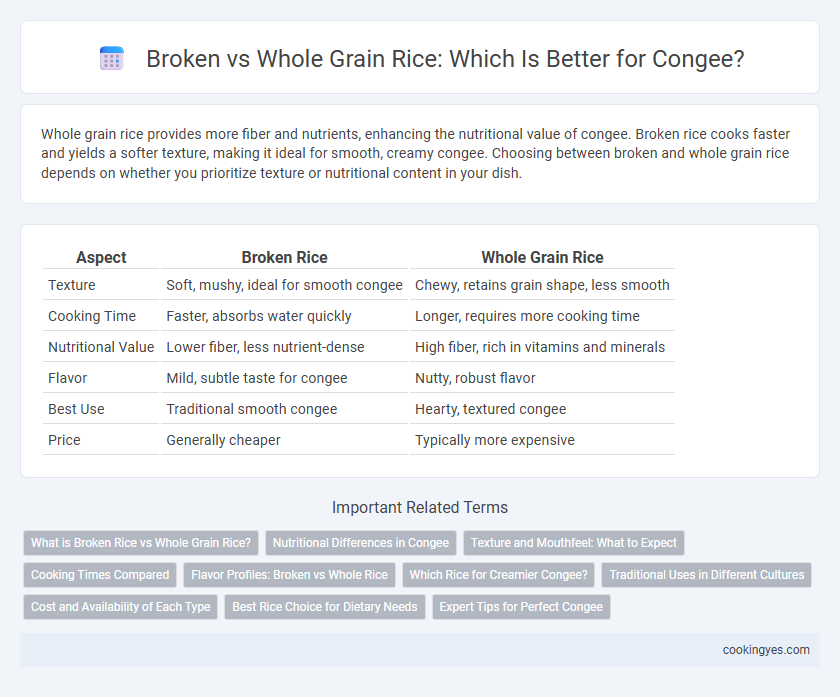Whole grain rice provides more fiber and nutrients, enhancing the nutritional value of congee. Broken rice cooks faster and yields a softer texture, making it ideal for smooth, creamy congee. Choosing between broken and whole grain rice depends on whether you prioritize texture or nutritional content in your dish.
Table of Comparison
| Aspect | Broken Rice | Whole Grain Rice |
|---|---|---|
| Texture | Soft, mushy, ideal for smooth congee | Chewy, retains grain shape, less smooth |
| Cooking Time | Faster, absorbs water quickly | Longer, requires more cooking time |
| Nutritional Value | Lower fiber, less nutrient-dense | High fiber, rich in vitamins and minerals |
| Flavor | Mild, subtle taste for congee | Nutty, robust flavor |
| Best Use | Traditional smooth congee | Hearty, textured congee |
| Price | Generally cheaper | Typically more expensive |
What is Broken Rice vs Whole Grain Rice?
Broken rice consists of fragments of rice grains that are broken during the milling process, resulting in smaller, irregular pieces compared to whole grain rice. Whole grain rice retains the entire kernel, including the bran, germ, and endosperm, providing a fuller texture and higher nutritional value. For congee, broken rice cooks faster and yields a creamier, softer consistency, while whole grain rice offers a chewier texture and richer fiber content.
Nutritional Differences in Congee
Whole grain rice retains the bran and germ, providing higher fiber, vitamins B and E, and essential minerals like magnesium and zinc compared to broken rice. Broken rice, while often softer and quicker to cook, generally has lower nutritional content due to the removal of these nutrient-dense parts. Congee made from whole grain rice offers improved digestion and sustained energy release, supporting better glycemic control and enhanced overall nutrient intake.
Texture and Mouthfeel: What to Expect
Broken rice grains create a softer, creamier texture in congee, enhancing its smooth and velvety mouthfeel. Whole grain rice maintains a slightly firmer texture, offering a more substantial bite and distinct grain presence. Expect broken rice congee to be silkier and more cohesive, while whole grain yields a heartier, chewier experience.
Cooking Times Compared
Broken rice grains cook faster than whole grains due to their smaller size and fractured structure, making them ideal for congee recipes requiring shorter simmering times. Whole grain rice retains its bran, resulting in longer cooking times but providing a chewier texture and higher nutritional value. Choosing between broken and whole grain rice depends on desired congee consistency and cooking time availability.
Flavor Profiles: Broken vs Whole Rice
Broken rice grains enhance congee with a softer texture and slightly sweeter, nuttier flavor due to their increased surface area, allowing better water absorption and starch release. Whole grain rice imparts a firmer, chewier consistency and a more robust, earthy taste, preserving more of the grain's bran and germ. The choice between broken and whole rice depends on desired congee texture and flavor intensity, with broken rice offering creaminess and whole grain providing depth.
Which Rice for Creamier Congee?
Broken rice grains release more starch during cooking, resulting in a creamier texture ideal for congee. Whole grain rice retains its structure, producing a slightly firmer congee with distinct rice grains. For a smooth, velvety congee, broken rice is preferred due to its higher surface area and starch content.
Traditional Uses in Different Cultures
Broken rice is preferred in many Asian cultures for congee due to its softer texture and quicker cooking time, enhancing the porridge's creamy consistency. Whole grain rice, often used in Japanese okayu or Korean juk, provides a chewier texture and retains more nutrients, reflecting regional dietary preferences. These traditional uses demonstrate the cultural significance of rice variety choices in preparing congee, balancing flavor, texture, and nutrition.
Cost and Availability of Each Type
Broken rice is generally more affordable and widely available in markets due to its lower quality and byproduct status, making it a popular choice for congee in cost-sensitive households. Whole grain rice, being less processed, tends to have a higher price and may not be as easily found in all local stores, often preferred by consumers seeking nutritional benefits. Availability of broken rice is typically consistent in regions with high rice production, while whole grain rice might require specialty suppliers or organic markets.
Best Rice Choice for Dietary Needs
Whole grain rice is ideal for congee when prioritizing fiber content and nutrient density, supporting digestive health and sustained energy release. Broken rice, consisting of fractured grains, cooks faster and creates a softer texture but has a lower nutritional value compared to whole grains. Choosing whole grain varieties like brown or red rice enhances congee's glycemic control and satiety, aligning with diabetes-friendly and weight management dietary needs.
Expert Tips for Perfect Congee
Using whole grain rice for congee yields a richer texture and higher nutritional value, as it retains the bran and germ, offering more fiber and vitamins. Broken rice, with its smaller fragmented grains, cooks faster and creates a smoother, creamier consistency ideal for traditional congee. Experts recommend soaking broken rice before cooking to enhance softness while whole grain rice benefits from longer simmering to fully release its flavors and nutrients.
Broken vs Whole grain for congee Infographic

 cookingyes.com
cookingyes.com